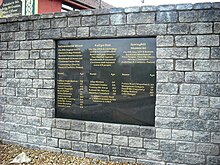Ballymurphy was just outright callous murder on a grand scale, one poor woman was shot six times in the abdomen and left to die in field for something like six hours and was refused hospital treatment, if an ambulance had been allowed to go to her she would have survived.
Think they shot a priest too and a father and son.

Commemoration plaque in a remembrance garden in
Ballymurphy, Belfast
Six civilians were killed on 9 August:
- Francis Quinn (19), shot while going to the aid of a wounded man.[12][13]
- Fr. Hugh Mullan (38), a Catholic priest, shot while going to the aid of a wounded man, reputedly while waving a white cloth to indicate his intentions.[12][14][15]
- Joan Connolly (44), shot as she stood opposite the army base. It has been claimed she was shot by three soldiers and that she might have survived had she been given medical attention sooner but she lay injured in a field for several hours[12][16][17][15]
- Daniel Teggart (44), was shot fourteen times. Most of the bullets entered his back, allegedly as he lay injured on the ground.[12][18]
- Noel Phillips (20), shot as he stood opposite the army base.[12][19]
- Joseph Murphy (41), shot as he stood opposite the army base.[12] Murphy was subsequently taken into army custody and after his release, as he was dying in hospital, he claimed that he had been beaten and shot again while in custody. When his body was exhumed in October 2015, a second bullet was discovered in his body, which activists said corroborated his claim.[20]
One civilian was shot on 10 August and another four were shot on 11 August:
- Edward Doherty (28), shot while walking along Whiterock Road.[21]
- John Laverty (20) and Joseph Corr (43) were shot at separate points at the top of the Whiterock Road. Laverty was shot twice, once in the back and once in the back of the leg. Corr was shot several times and died of his injuries on 27 August.[12][22]
- John McKerr (49), shot by unknown attackers while standing outside a Catholic church, died of his injuries on 20 August.[13][23][24]
- Paddy McCarthy (44) got into a confrontation with a group of soldiers. Family allege an empty gun was put in his mouth and the trigger pulled. McCarthy suffered a heart attack and died shortly afterwards.[25][26]
In February 2015, the conviction of Terry Laverty, younger brother of John, was quashed by the
Criminal Cases Review Commission.
[27] He had been convicted of riotous behaviour and sentenced to six months on the eye-witness evidence of a private in the Parachute Regiment. The case was referred to court because the sole witness retracted his evidence.
[28]
https://en.wikipedia.org/wiki/Ballymurphy_massacre
Joan’s Death
On August 9th 1971 "Internment without Trial" was introduced by the British Government in Northern Ireland. Men and women, young and old, were arrested and jailed without trial or reason. This was a date that would change the lives of Joan’s family forever. On this August evening the Parachute regiment of the British Army murdered Joan, a 45 year old mother of eight.
Joan was shot as she left her place of safety and went to the aid of a young boy (Noel Phillips) who was shot and wounded by the same regiment. Joan was shot several times in the head and body, with injuries so severe that part of her face was blown off. Joan's autopsy report indicates that Joan bled to death. Eye witnesses of the events claim Joan was blatantly refused emergency medical attention, even as she cried out for help.
The murder of Joan, the only woman shot in Ballymurphy during one of the trouble's worse events, left husband Denis without a wife and left eight children without a mother. The extent of Joan’s injuries was so horrific that Denis struggled to identify her body; he finally did on his third attempt aided only by Joan's red hair.
Joan’s family were in turmoil, not knowing what to do having suddenly lost their wife and mother. Denis, shocked by the situation and panicked by the on going trouble, sent his young daughters Denise (with baby Christopher), Briege, Joan, Maura and Irene to his family in the south of Ireland. Initially they had to endure a stay in a refugee camp, and this is where, having stumbled across the 12o'clock news one evening, Briege and Denise were to find out their mother was dead and had been buried. Both girls, shocked and stunned, only had each other for comfort as they mourned their mother’s death. Joan was branded an IRA woman, a claim that was never true and as a result, her death was not investigated properly.
http://ballymurphymassacre.com/jconnolly.htm

